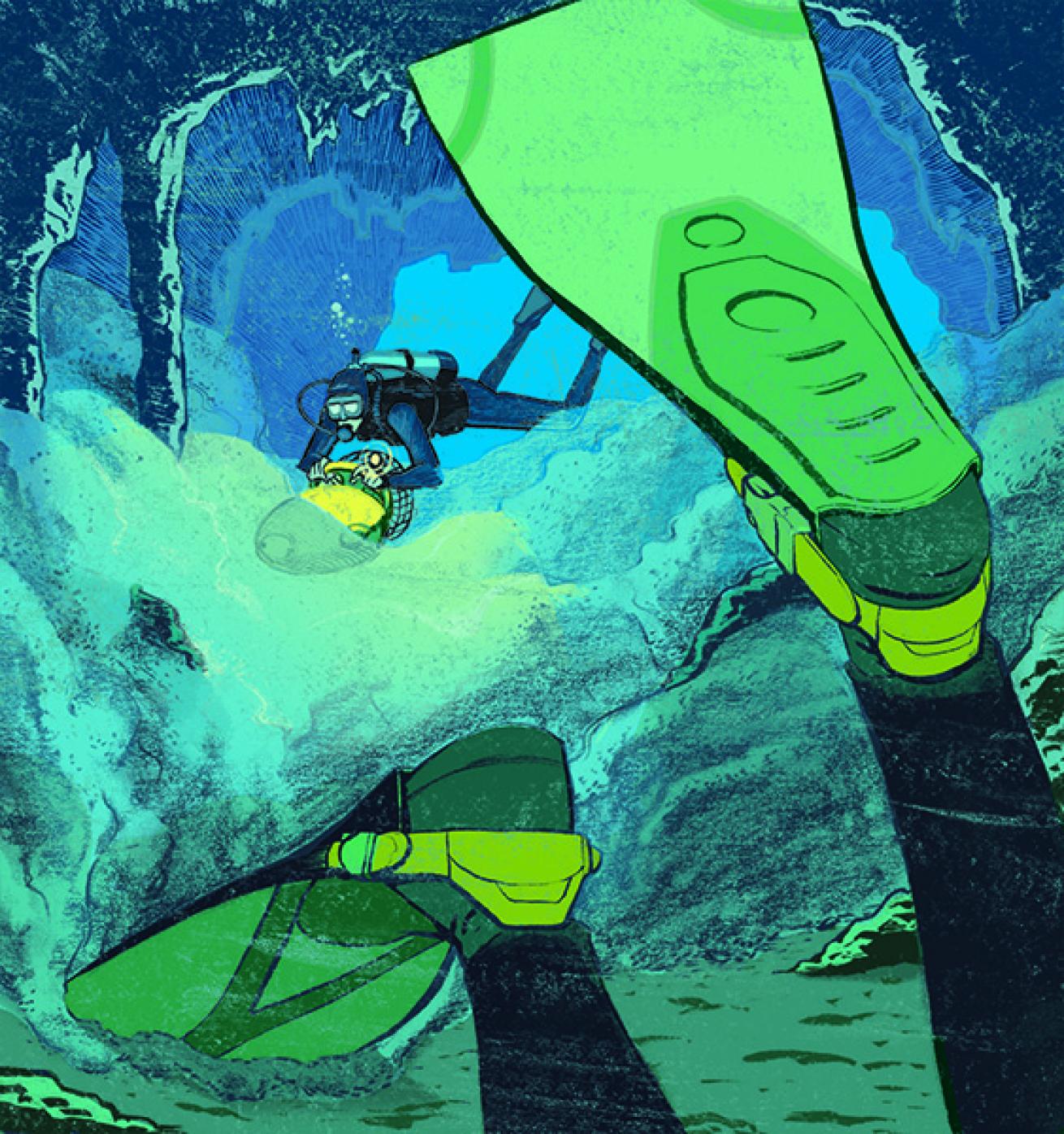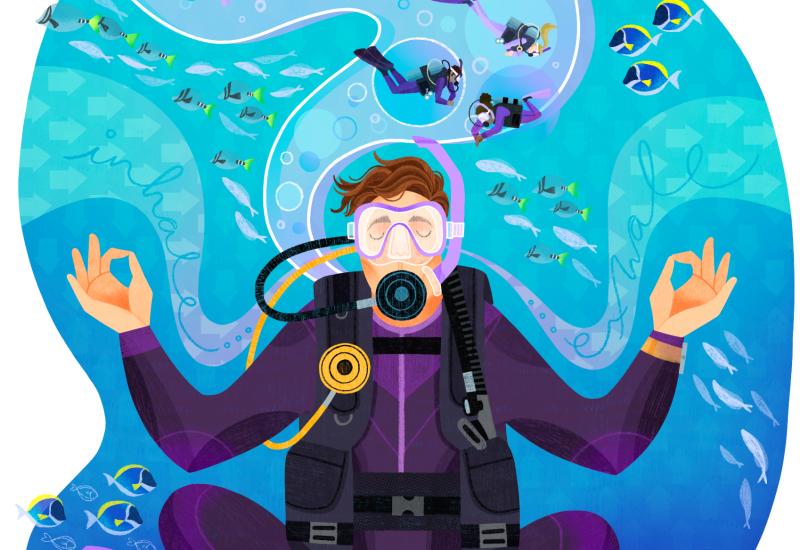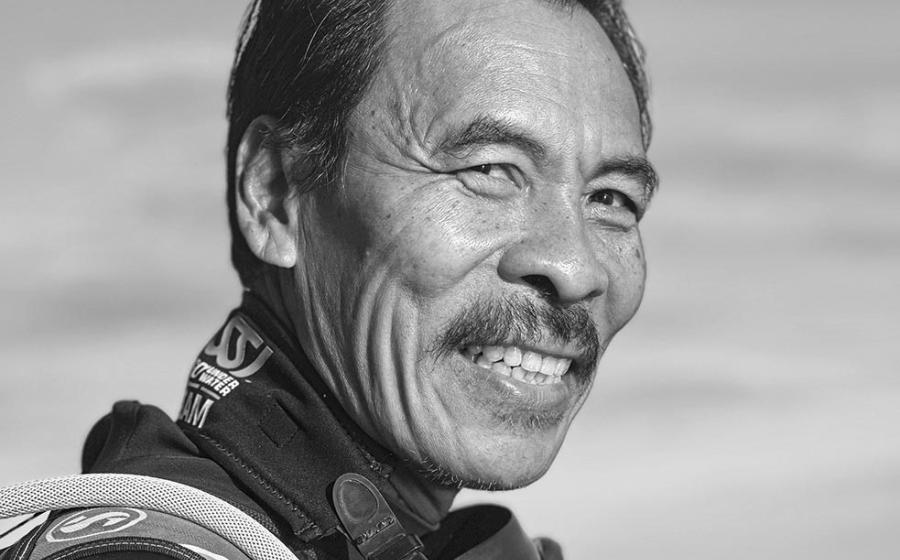Lessons for Life: Safe Cave Diving

Cave Diving: No Way Out
When Wally saw his buddy's fin drag across the flow, he let go of the trigger on his scooter.
Jori Bolton
When Wally finished his cavern-diver course, he wanted to go deeper and dive into longer cave systems. He wanted to be a full cave diver, but it was going to be a while before he got there. When his buddy suggested they use scooters to see how far they could get in the Florida cave system they had both heard about, he jumped at the chance.
The cave was nothing less than spectacular. Wally and his buddy turned when their air got low, and were heading back to the entrance when Wally’s buddy, who was in the lead, brushed a fin against the silt-covered bottom. His buddy was moving so fast on the scooter, he didn’t even realize what happened. The accidental touch caused a whiteout, and Wally couldn’t see. Wally let go of the trigger on the scooter to give the silt time to settle so he could see where he was going. When Wally could see again, his buddy was gone. Wally was alone in the cave and not sure how to find the way out.
THE DIVER
Wally grew up in Central Florida hearing stories about the cave systems and fresh-water springs beneath his feet. It was only recently, though, that he had the time and money to learn to dive. He had dived offshore, but what he really wanted to do was explore the caves in his backyard. Money was tight for Wally, and he didn’t have the resources to take a full cave-certification course or buy the necessary equipment. All he had managed to do so far was take a cavern-diver course. In it, he learned about the proper kicks to keep from silting out a cave and how to run a line into the cavern to find his way out. The cavern course whetted his appetite for more, but he didn’t know when he would be able to take that next step.
THE DIVE
When Wally’s buddy called and said he had access to two scooters for the weekend, they both knew where they wanted to go. The particular cave system was open only to qualified cave divers, but they knew some people who worked there, and they were able to drop some names and claimed to have finished their cave-diver course. They said they were still waiting on their certification cards. After some talking and storytelling, they were allowed to enter the cave system. Both divers were elated.
They both spent a few minutes in the open-water section outside the cave system getting used to the scooters, turning loops and pretending to be superheroes, before they went inside. After a quick check of each other’s gear, they pointed the scooters into the cave system and took off. At first they followed the permanent cave line inside the system. Riding the scooters and moving fast, they quickly passed beyond the reach of the line. After 20 minutes exploring the cave, Wally signaled to his buddy that he was down to half his tank. Prior to the dive, they had agreed to turn the dive following the rule of thirds as they had learned, but Wally hadn’t noticed that he had exceeded that limit until he was well past it. Realizing that Wally was low on air, and his buddy didn’t have much more, they took off toward the entrance. They both felt anxious and wanted to get to the surface, remembering several lessons they learned in the cavern course about gas management and running safety lines. They knew they had exceeded the limits, but only then did they realize they were in a dangerous situation.
THE ACCIDENT
Wally’s buddy was running about 25 feet ahead of him, but Wally could see his friend’s light with no problem. They were both riding the scooters as fast as they could. A new worry came into Wally’s head. He wasn’t sure how long the batteries on the scooter would last, especially running them wide open. He was getting nervous and wanted to be on the surface.
When Wally saw his buddy’s fin drag across the floor, he let go of the trigger. A cloud of silt rose up and he couldn’t see anything. He didn’t want to run into a wall, so he waited. The cave system had a constant flow of water, but it still took a few moments for the cloud to break up. Wally expected to see his buddy waiting on him on the other side of the silt. While he waited, he thought about what he was going to say to his friend about staying off the bottom and being careful.
When Wally could see again, he moved forward cautiously looking for his friend’s light. He didn’t see it and realized he was alone. And then it dawned on him. He had no idea how to get back to the permanent line in the cave.
ANALYSIS
Certified cave divers with experience recovering bodies brought Wally’s body to the surface a couple of hours later. Even if they had known where Wally was, it would not have been possible to get to him before he ran out of air. They found Wally’s body more than 2,000 feet inside the cave system. His scuba tank was empty.
Wally and his buddy made a series of mistakes, and they paid with Wally’s life. They took a little bit of knowledge and used it to go well beyond their training. They lied about their experience to gain access to a site reserved for people with much greater experience. Neither had more than a basic understanding of cave-diving techniques, and neither had the air supply and redundant equipment that cave divers consider an absolute necessity. They took scooters neither one had used before into a cave system without an understanding of how far the scooters would allow them to travel.
Cave divers usually follow the rule of thirds for gas management. That means they use one third of their air on the way in and one third on the way out. The final third is held in reserve in case there is a problem. By moving forward until the halfway point on his air tank, Wally didn’t have any reserve to fall back on.
All of these mistakes compounded each other, and they all led to the accident. This is often the case. One small slip-up doesn’t often lead to a problem. But when several lapses in judgment are added in, they can prove fatal. This is especially true when panic sets in. In Wally’s case, he was starting to get nervous at the turn point of the dive when he realized he was lower on air than he should be. The whiteout in the cave probably made him that much more nervous. While we will never really know what happened in the last few minutes of his life, it is likely that Wally wasn’t thinking rationally. Panic set in, and there was nothing he could do.
LESSONS FOR LIFE
1. Do not enter a cave system without the proper training and equipment. There is nothing to see there worth dying for.
2 Be familiar with all equipment before you use it, and definitely before you use it in a critical situation.
3 Any time you have to make up a story to be able to enter a dive site, don’t do it. Be properly prepared before the dive.

Jori BoltonWhen Wally saw his buddy's fin drag across the flow, he let go of the trigger on his scooter.
When Wally finished his cavern-diver course, he wanted to go deeper and dive into longer cave systems. He wanted to be a full cave diver, but it was going to be a while before he got there. When his buddy suggested they use scooters to see how far they could get in the Florida cave system they had both heard about, he jumped at the chance.
The cave was nothing less than spectacular. Wally and his buddy turned when their air got low, and were heading back to the entrance when Wally’s buddy, who was in the lead, brushed a fin against the silt-covered bottom. His buddy was moving so fast on the scooter, he didn’t even realize what happened. The accidental touch caused a whiteout, and Wally couldn’t see. Wally let go of the trigger on the scooter to give the silt time to settle so he could see where he was going. When Wally could see again, his buddy was gone. Wally was alone in the cave and not sure how to find the way out.
THE DIVER
Wally grew up in Central Florida hearing stories about the cave systems and fresh-water springs beneath his feet. It was only recently, though, that he had the time and money to learn to dive. He had dived offshore, but what he really wanted to do was explore the caves in his backyard. Money was tight for Wally, and he didn’t have the resources to take a full cave-certification course or buy the necessary equipment. All he had managed to do so far was take a cavern-diver course. In it, he learned about the proper kicks to keep from silting out a cave and how to run a line into the cavern to find his way out. The cavern course whetted his appetite for more, but he didn’t know when he would be able to take that next step.
THE DIVE
When Wally’s buddy called and said he had access to two scooters for the weekend, they both knew where they wanted to go. The particular cave system was open only to qualified cave divers, but they knew some people who worked there, and they were able to drop some names and claimed to have finished their cave-diver course. They said they were still waiting on their certification cards. After some talking and storytelling, they were allowed to enter the cave system. Both divers were elated.
They both spent a few minutes in the open-water section outside the cave system getting used to the scooters, turning loops and pretending to be superheroes, before they went inside. After a quick check of each other’s gear, they pointed the scooters into the cave system and took off. At first they followed the permanent cave line inside the system. Riding the scooters and moving fast, they quickly passed beyond the reach of the line. After 20 minutes exploring the cave, Wally signaled to his buddy that he was down to half his tank. Prior to the dive, they had agreed to turn the dive following the rule of thirds as they had learned, but Wally hadn’t noticed that he had exceeded that limit until he was well past it. Realizing that Wally was low on air, and his buddy didn’t have much more, they took off toward the entrance. They both felt anxious and wanted to get to the surface, remembering several lessons they learned in the cavern course about gas management and running safety lines. They knew they had exceeded the limits, but only then did they realize they were in a dangerous situation.
THE ACCIDENT
Wally’s buddy was running about 25 feet ahead of him, but Wally could see his friend’s light with no problem. They were both riding the scooters as fast as they could. A new worry came into Wally’s head. He wasn’t sure how long the batteries on the scooter would last, especially running them wide open. He was getting nervous and wanted to be on the surface.
When Wally saw his buddy’s fin drag across the floor, he let go of the trigger. A cloud of silt rose up and he couldn’t see anything. He didn’t want to run into a wall, so he waited. The cave system had a constant flow of water, but it still took a few moments for the cloud to break up. Wally expected to see his buddy waiting on him on the other side of the silt. While he waited, he thought about what he was going to say to his friend about staying off the bottom and being careful.
When Wally could see again, he moved forward cautiously looking for his friend’s light. He didn’t see it and realized he was alone. And then it dawned on him. He had no idea how to get back to the permanent line in the cave.
ANALYSIS
Certified cave divers with experience recovering bodies brought Wally’s body to the surface a couple of hours later. Even if they had known where Wally was, it would not have been possible to get to him before he ran out of air. They found Wally’s body more than 2,000 feet inside the cave system. His scuba tank was empty.
Wally and his buddy made a series of mistakes, and they paid with Wally’s life. They took a little bit of knowledge and used it to go well beyond their training. They lied about their experience to gain access to a site reserved for people with much greater experience. Neither had more than a basic understanding of cave-diving techniques, and neither had the air supply and redundant equipment that cave divers consider an absolute necessity. They took scooters neither one had used before into a cave system without an understanding of how far the scooters would allow them to travel.
Cave divers usually follow the rule of thirds for gas management. That means they use one third of their air on the way in and one third on the way out. The final third is held in reserve in case there is a problem. By moving forward until the halfway point on his air tank, Wally didn’t have any reserve to fall back on.
All of these mistakes compounded each other, and they all led to the accident. This is often the case. One small slip-up doesn’t often lead to a problem. But when several lapses in judgment are added in, they can prove fatal. This is especially true when panic sets in. In Wally’s case, he was starting to get nervous at the turn point of the dive when he realized he was lower on air than he should be. The whiteout in the cave probably made him that much more nervous. While we will never really know what happened in the last few minutes of his life, it is likely that Wally wasn’t thinking rationally. Panic set in, and there was nothing he could do.
LESSONS FOR LIFE
1. Do not enter a cave system without the proper training and equipment. There is nothing to see there worth dying for.
2 Be familiar with all equipment before you use it, and definitely before you use it in a critical situation.
3 Any time you have to make up a story to be able to enter a dive site, don’t do it. Be properly prepared before the dive.










